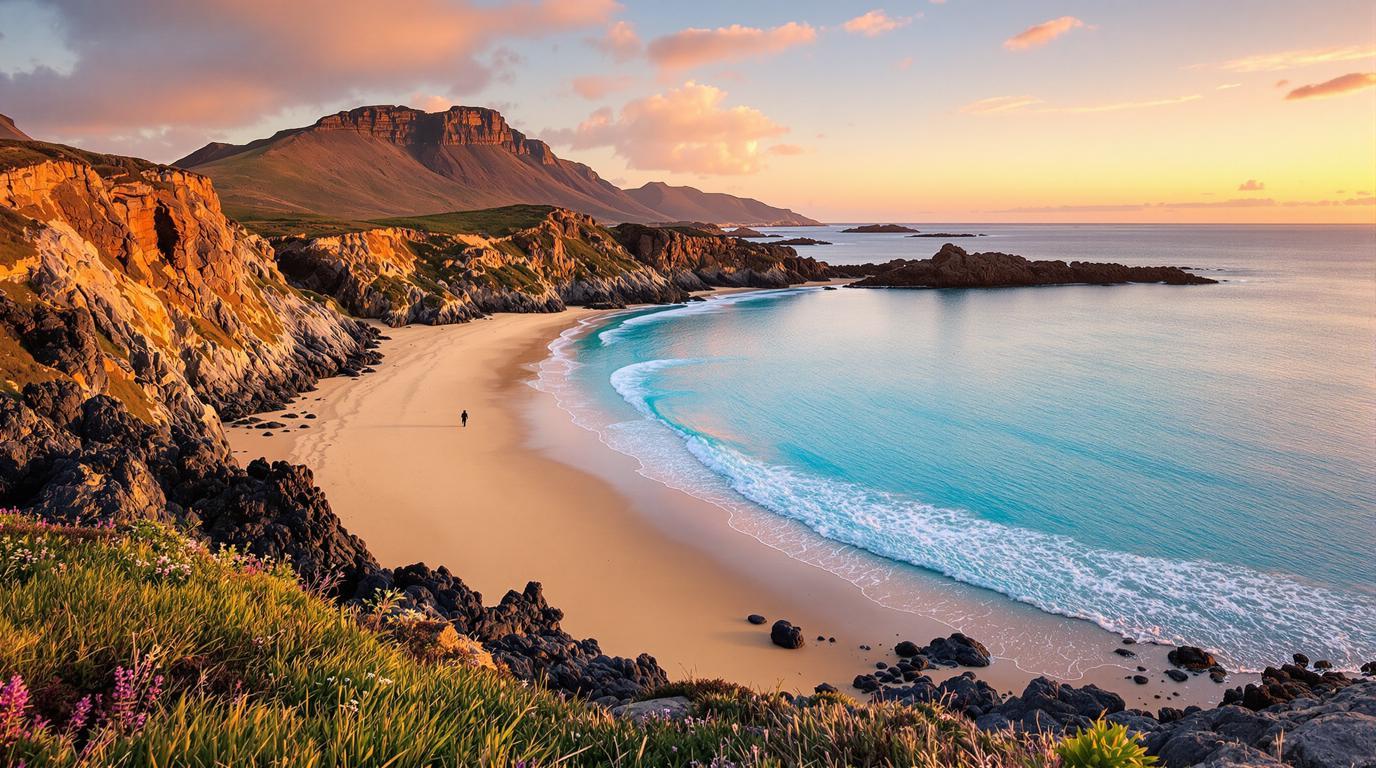Scotland’s smallest islands often hide its greatest treasures. With just 125 residents and spanning barely 10 square miles, Colonsay emerges from the Hebridean waters as Scotland’s best-kept beach secret. While millions flock to Mediterranean shores, this remote Atlantic gem offers something increasingly rare: pristine golden beaches without footprints, crystalline waters without crowds, and a profound sense of discovery.
Kiloran Bay: Scotland’s most perfect crescent
Golden sand meets turquoise waters at Kiloran Bay, Colonsay’s crown jewel. This stunning crescent beach stretches along the island’s northwest coast, offering a visual surprise that challenges perceptions of Scottish beaches. The bay’s sheltered position makes swimming possible even in Scotland’s notoriously fickle summer weather.
“Our waves rival Cornwall’s for surfing, but you’ll rarely share them with more than two other people,” explains a local surf enthusiast. “On sunny days, the water clarity rivals the Caribbean – just a wee bit colder!”
The magical tidal crossing to Oronsay
Perhaps Colonsay’s most enchanting feature is The Strand – a tidal sandbar connecting it to neighboring Oronsay. For about four hours during low tide, visitors can walk across the seafloor to explore this uninhabited island and its 14th-century priory ruins. The experience offers a profound connection to ancient pilgrimage routes that once crisscrossed these islands.
Time your crossing carefully – the returning tide waits for no one, much like the hidden emerald swimming pools in Southern France’s secret waterfalls.
Balnahard Bay: The reward for adventurers
For those willing to venture further, Balnahard Bay delivers isolated perfection. Accessible only via a picturesque 40-minute walk (or 20-minute cycle) from Balnahard Farm, this remote northern beach offers sweeping views of Mull and Jura. Its windswept dunes and expansive shoreline create a wilderness experience reminiscent of untouched coastal landscapes.
Wildlife encounters between beach visits
Colonsay’s beaches aren’t just for sunbathing – they’re living ecosystems teeming with wildlife. Grey seals regularly haul out on rocky outcrops, while lucky visitors might spot otters hunting along the shoreline. The island also hosts rare corncrakes and magnificent golden eagles that soar above the coastal cliffs.
Nature enthusiasts may find parallels to Brazil’s dolphin-filled bays, though Colonsay’s charm lies in its rugged northern beauty.
Gardens in paradise: Colonsay House
Between beach excursions, the 20-acre Colonsay House Gardens provide a stunning botanical surprise. Sheltered from Atlantic winds, these gardens nurture an improbable collection of rhododendrons and subtropical plants that thrive in the Gulf Stream’s warming influence.
“People imagine Scotland as all heather and thistles, then they visit our gardens and find palm trees and exotic flowers. The island constantly challenges expectations,” says the garden curator.
Practical beach essentials
While Colonsay’s beaches rival tropical destinations, Scotland’s weather demands preparation. Pack layers – even summer days can turn breezy. The island’s single-track roads are perfect for cycling between beaches, similar to Greece’s hidden island footpaths.
Accommodation is limited to a handful of cottages and the Colonsay Hotel, so book months ahead. Ferries from Oban take 2.5 hours and don’t run daily – another layer of protection for this unspoiled paradise.
A final golden hour
As sunset approaches, return to Kiloran Bay. Watch as the sinking sun transforms the golden sands into a canvas of amber and rose, while distant Jura’s mountains turn purple against the horizon. In this moment, you’ll understand why these beaches remain Scotland’s secret paradise – their magic isn’t just in their beauty, but in the soul-stirring solitude they offer in an increasingly connected world.
